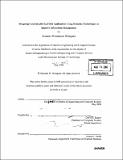Designing customizable end user applications using semantic technologies to improve information management
Author(s)
Watugala, Sumudu Weerakoon
DownloadFull printable version (13.42Mb)
Other Contributors
Massachusetts Institute of Technology. Dept. of Electrical Engineering and Computer Science.
Advisor
David R. Karger.
Terms of use
Metadata
Show full item recordAbstract
Personalization capabilities in computer applications attempt to better meet the needs of individuals. The more traditional and widespread paradigm in application design is that the user should adapt to the available application. This requires that the individual user's task be sliced and molded to fit the dimensions offered by an inflexible, monolithic application. It is desirable to have an application that can be shaped to fit each individual user's dynamic needs. However, it is important that this is done in an intuitive and unobtrusive way. In this thesis, we design and evaluate a personalizable application developed to aid life science researchers in their work. We designed the application in Haystack, a platform for developing semantic applications and user interfaces. The application gave the user flexibility in personalizing the way in which information is organized and displayed, while giving users access to the tools necessary to perform their tasks. We selected researchers as the user group to focus on because of the inherent necessity in their work for originality and dynamic adaptation. Life sciences research was chosen as the domain due to its potential to benefit from the application of semantic technologies. We tested how users reacted and adapted to this application by conducting a formal user study.
Description
Thesis (M. Eng.)--Massachusetts Institute of Technology, Dept. of Electrical Engineering and Computer Science, June 2006. "May 2006." Includes bibliographical references (leaves 152-155).
Date issued
2006Department
Massachusetts Institute of Technology. Department of Electrical Engineering and Computer SciencePublisher
Massachusetts Institute of Technology
Keywords
Electrical Engineering and Computer Science.